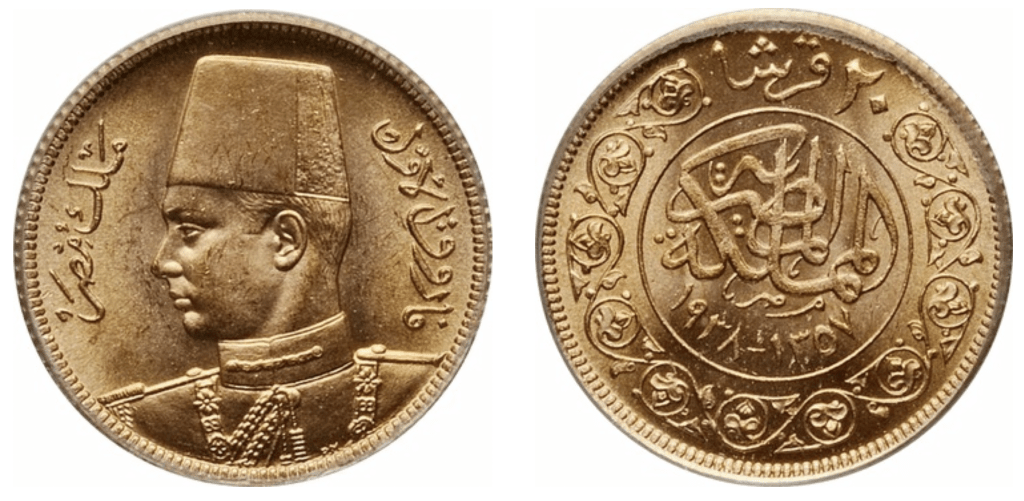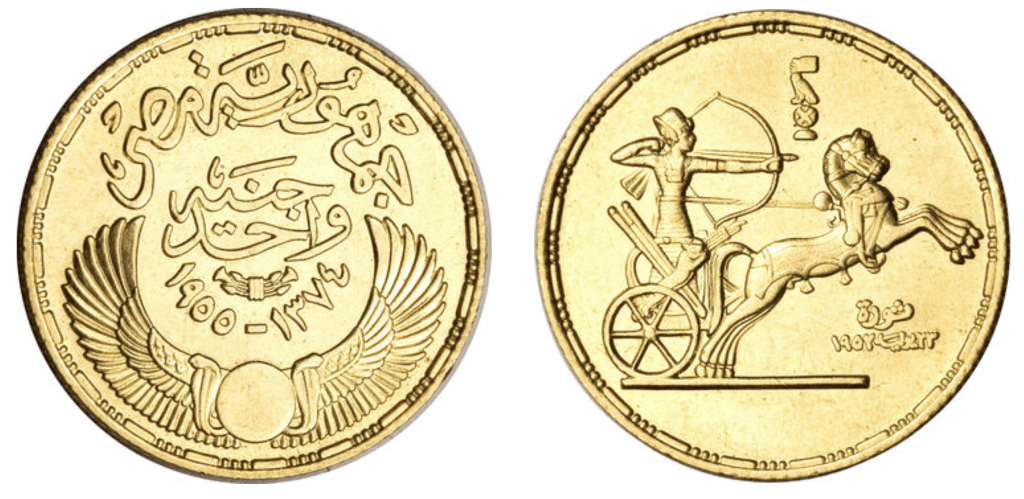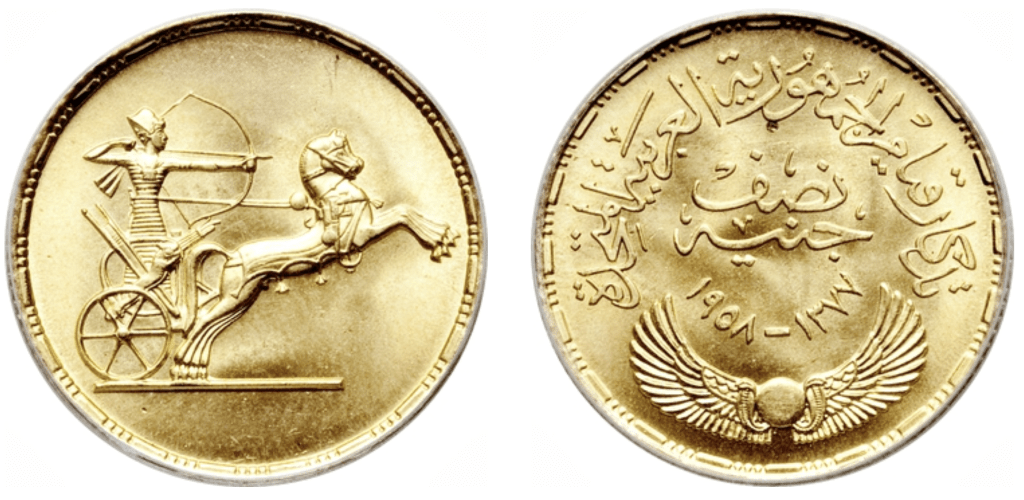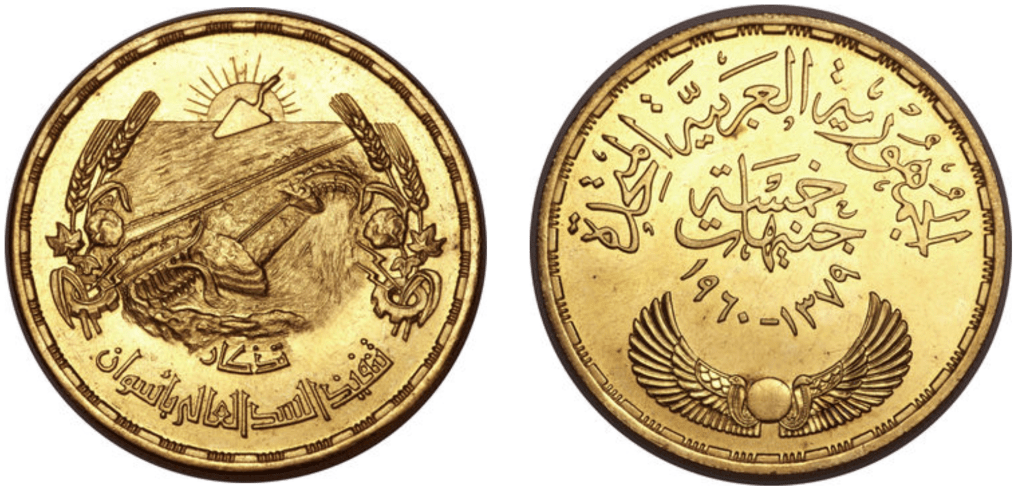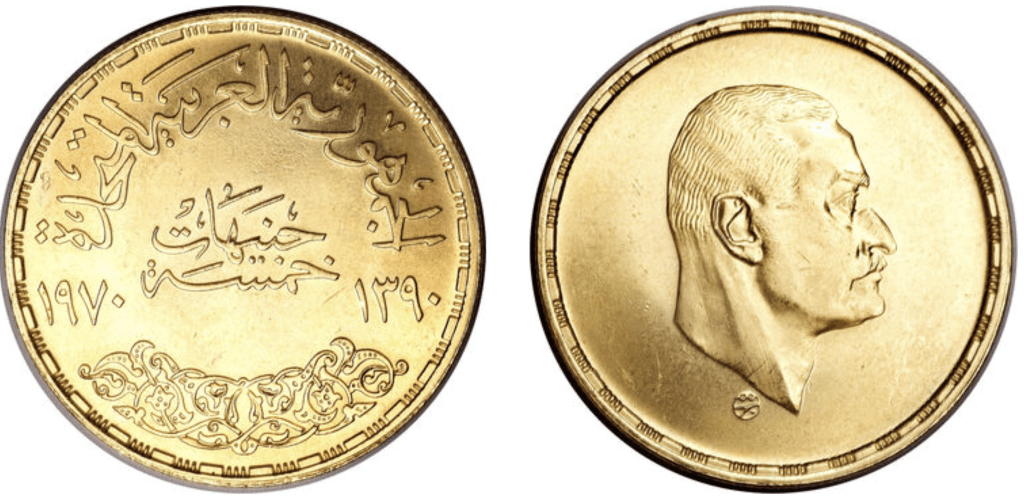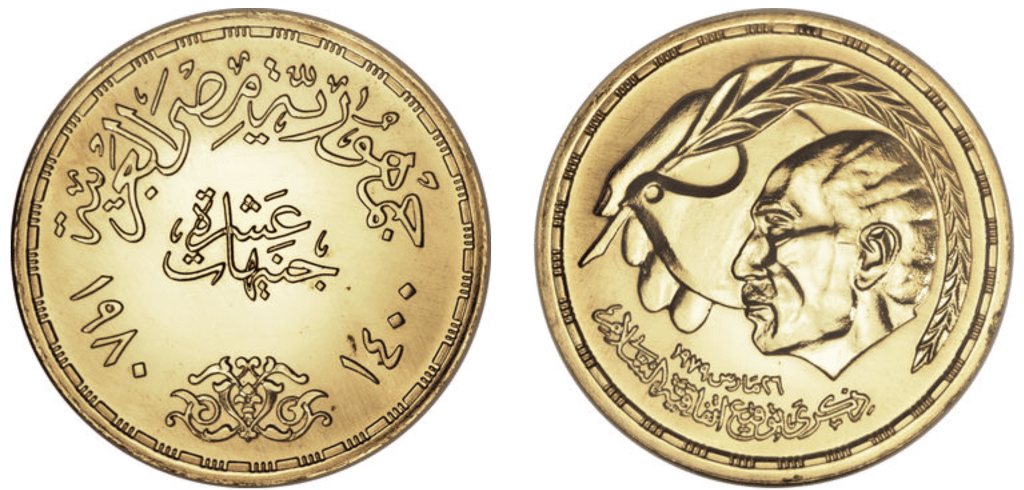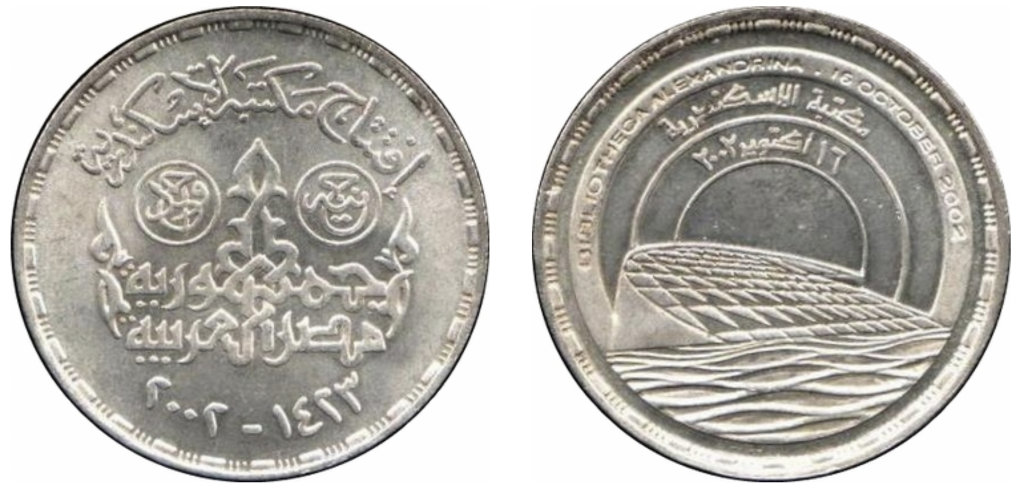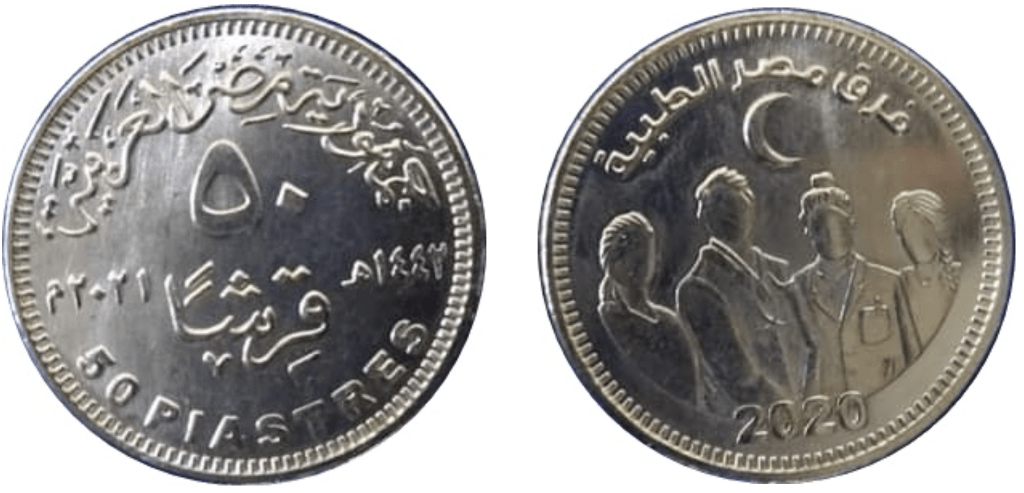In September 2022, the Egyptian Ministry of Finance’s proposal to introduce the country’s first-ever two-pound coin was approved by the cabinet. To meet rising inflation and the needs of a mostly cash-based economy, the two-pound coin will join the one-pound coin, 50-piastres coin, and 25-piasters coin. However, while Egypt lacks the numerous coin denominations that its neighbors have, the Central Bank of Egypt has for decades been minting numerous commemorative coins that mark and reflect the nation’s modern history through wars and revolutions. These commemorative coins mark great events that changed the course of the country’s history, the country’s most notable men and women are presidents or musicians, markers of national pride, and other events and institutions that make up a constructed national history. Looking back through Egypt’s commemorative coins brings you through not just a history of modern Egypt, but a notion of the state’s aspirations and its achievements that are understood as worth cherishing. It is not so much a history of how it was, but a very selective understanding of the nation’s history. Looking through historical and commemorative coins can open up new narratives and ways of framing the past, for there are always two sides to every coin.
Marriage of King Farouk I and Lady Farida: 1938
Following the union of King Farouk and Queen Farida known by Safinaz Zulficar, in 1938 at Qubba Palace the two inaugurated their marriage and three daughters soon followed. However, unlike previous royal marriages, the increasing concern of maintaining the popularity of the Egyptian royal family meant that it was a highly publicized event and Queen Farida had a very public role, unlike female members of the royal family before her. To my knowledge, this is the first commemorative coin ever issued in Egypt, and it is telling that the marriage between Farida and Farouk was the event to start this trend that the Central Bank of Egypt would carry out through the coming century.
Commemoration of the July 23rd Revolution of 1952: 1955
The Egyptian Revolution of 1952 saw the overthrow of the British-backed monarchy by the Free Officer Movement led by Mohamed Naguib and Gamal Abdel Nasser. However, for many years after the revolution, the currency used still had the faces and symbols of the deposed monarchy. This was steadily replaced with a currency that reflected the new republic and some commemorative coins were issued to mark the overthrowing of the unpopular monarchy.
Evacuation of the British in 1956: 1956
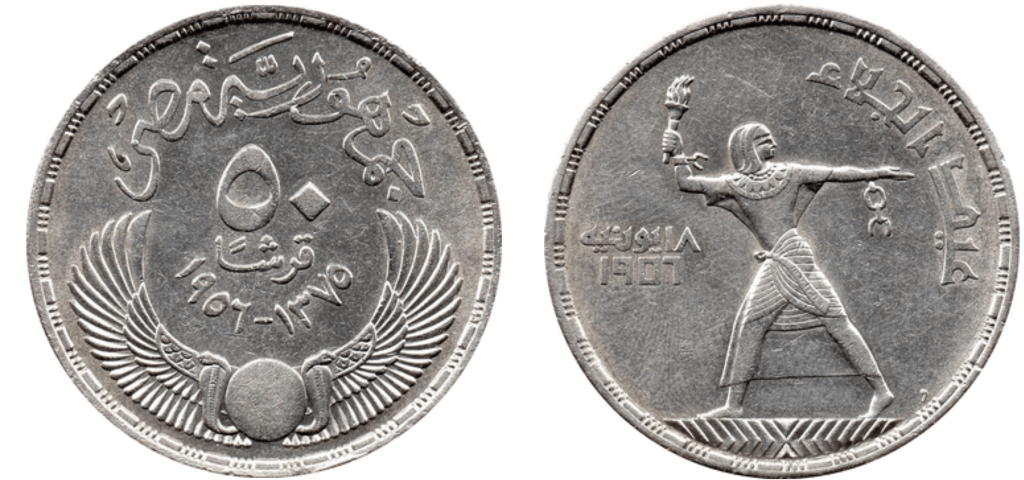
Although technically an independent kingdom from 1922 onwards, the British Army maintained a hated and untrusted presence around the Suez Canal. However, following the Tripartite Aggression that saw the United Kingdom conspire with France and Israel to overtake the area surrounding the Suez Canal, the occupying forces were humiliatingly defeated and forced to retreat. As such, 1956 marked not just the evacuation of occupying British troops from Egypt, but the first time in 2500 years in which the country was not ruled by a foreign leader or occupied by foreign forces.
Establishment of the United Arab Republic: 1958
In 1958, Egypt and Syria joined to become the United Arab Republic. However, Syria left in 1961 following a coup d’etat and the United Arab Republic formally dissolved in 1971. While awash with difficulties from the very beginning, the United Arab Republic encapsulated the hopes and aspirations of pan-Arabism of the 50s and 60s.
The Construction of the Aswan High Dam: 1960
For many years, great effort and funds had been put into building the Aswan High Dam. At the time it was the world’s biggest dam and the scale of the project received astonishment at home and abroad. Officially, construction started in 1960 and the dam was fully completed in 1970. The dam has been promoted as a symbol of national pride and an indicator of the nation’s modernist and developmental aspirations.
Commemorating the Death of President Nasser: 1970
In 1970, Egyptian President Gamal Abdel Nasser died of a heart attack. On October 1 of that year, it is estimated that around five million people thronged the streets to pay their respects. While Nasser became a contested and controversial figure in later years, at the time he was considered an inspirational figure too much of the country and the wider Arab world. Regardless of one’s opinion of the man himself, arguably no other person has been so influential in shaping modern Egypt.
First Anniversary of 6th October 1973 War: 1974
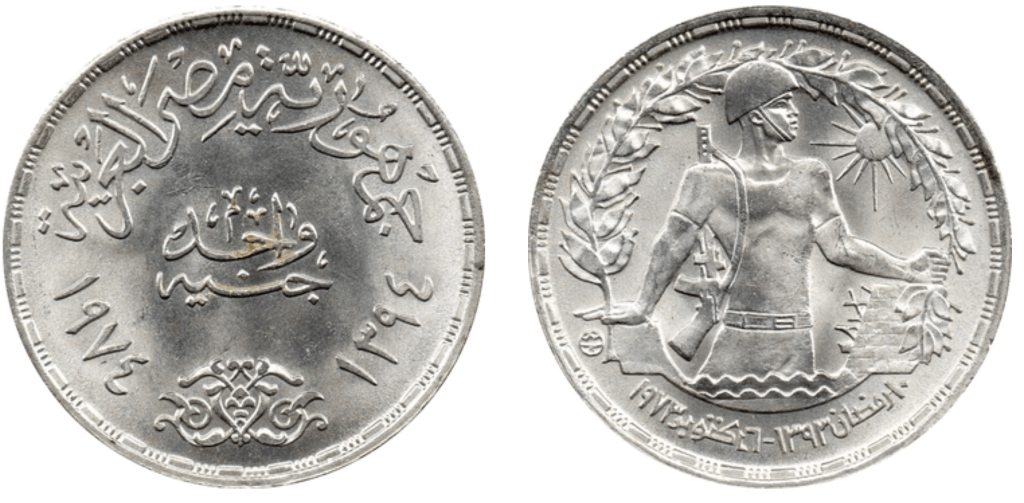
Even just a year after the 1973 October War, commemorative coins were being minted to celebrate the recapturing of parts of the Sinai and victory over Israeli forces. This coin become the first of many that would commemorate this victory and memorialize its martyrs.
International Women’s Year: 1975
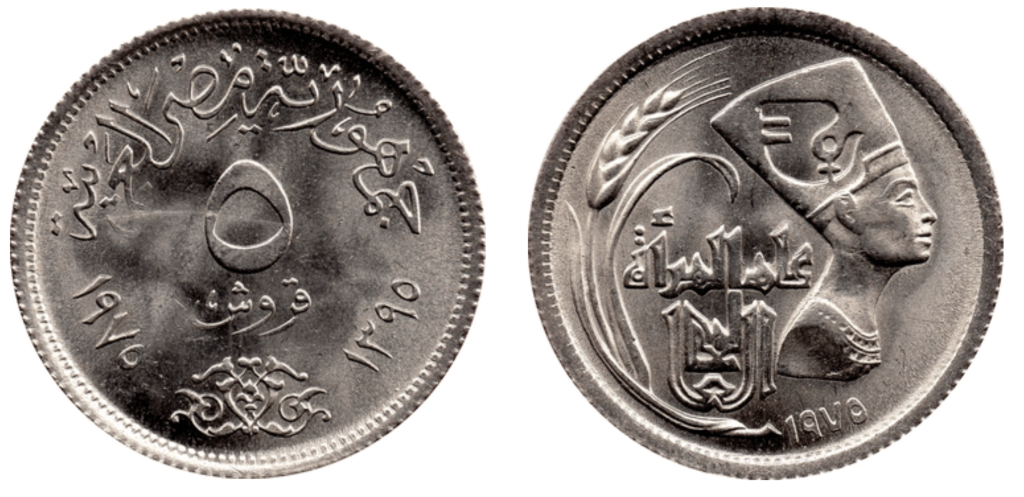
1975 was marked by the United Nations as being International Women’s Year. Around the world and in Egypt, events and initiatives were held to promote the rights of women and establish equality socially, politically, culturally, and legally.
Commemorating Umm Kulthum’s Death in 1977: 1978
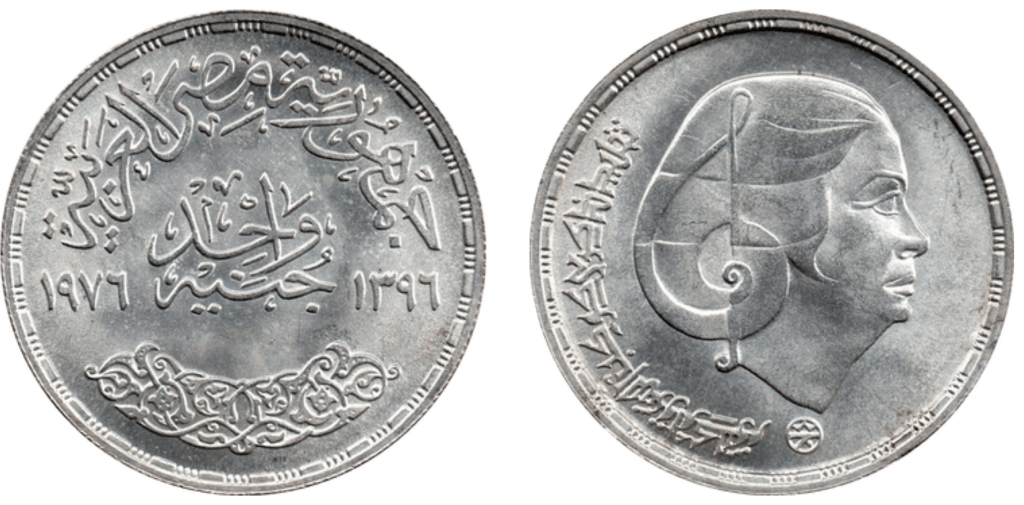
The singer Umm Kulthum was known as the Star of the East and was arguably the greatest ever Arab singer. Her music remains incredibly popular to this day and her death at the time brought around four million mourners to the streets to pay her respects.
One Year Anniversary of the Signing of the Egyptian-Israeli Peace Treaty of 1979: 1980
In 1979, President Sadat signed a controversial peace treaty with Israel. While this event is often not spoken about or memorialized by the organs of the state, in 1980 the Central Bank of Egypt issued this commemorative coin.
Sadat’s Corrective Revolution of May 15, 1971: 1980
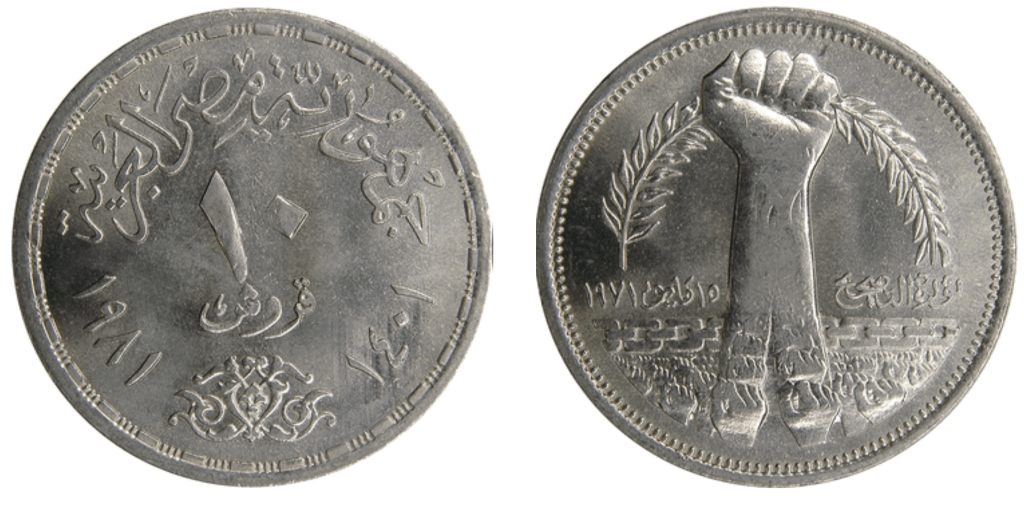
When Sadat took over from Nasser, one of his main objectives was to shift the country away from its previous direction under Nasser. The army, government and state institutions were purged of those seen as pro-Nasser or left wing. The Corrective Revolution of 1971 also saw a turn away from the USSR in terms of foreign policy and instead towards the USA.
25th Anniversary of the Nationalization of the Suez Canal: 1981
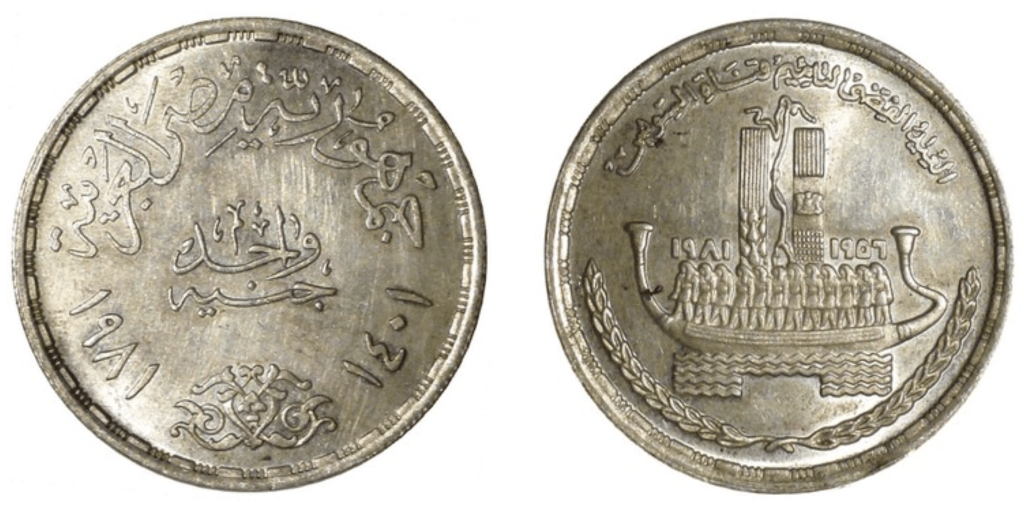
In 1956, President Gamal Abdel Nasser announced the nationalization of the Suez Canal. For decades, many saw foreign control of the Suez Canal as an exploitative and humiliating left-over from previous colonial rule. Its nationalization in 1956 was an important part in the nation’s independence and gave many a sense of national pride and strength.
100th Anniversary of the Urabi Revolution: 1981
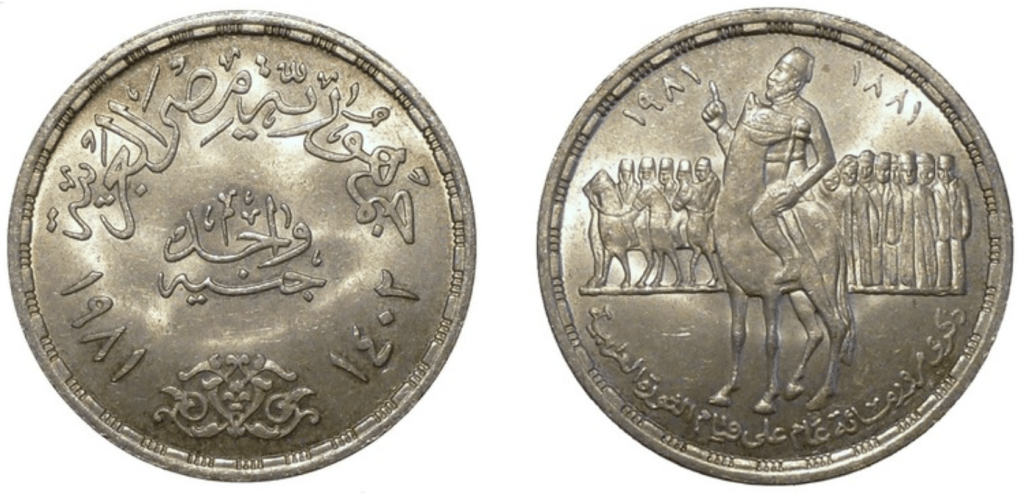
From 1879 to 1882, Ahmed Urabi led an uprising against the British. Urabi and his revolt are remembered as an important part of Egypt’s struggle for independence and the overthrow of a British- and French-aligned monarchy. Although defeated, the efforts of those and his soldiers are seen as a proud moment in the nation’s history.
Return of Sinai to Egypt: 1982
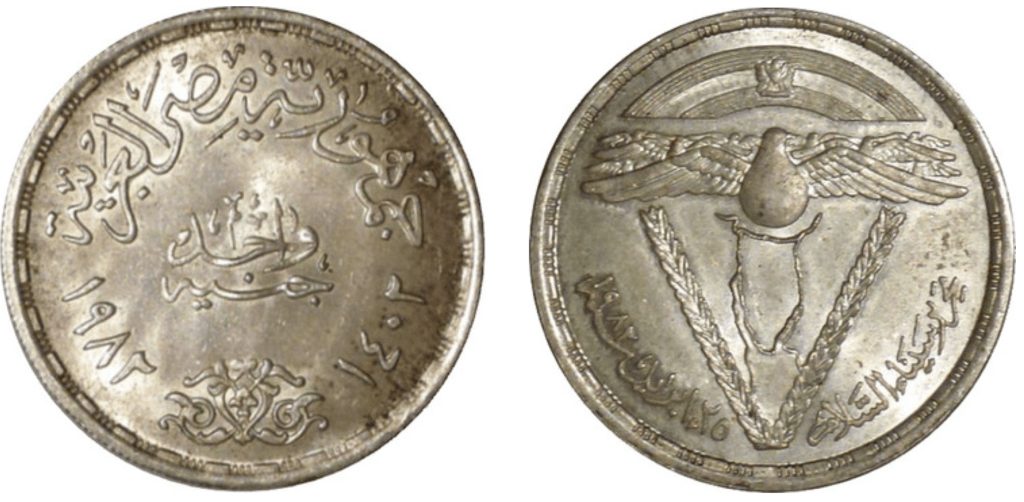
After several years of Israeli occupation, advances and retreats, the Sinai was formally returned to Egypt in 1982 after Israel abandoned and dismantled several militaries and airforce bases. As part of the peace agreement signed in 1979, organs of the state were keen to promote any benefits this unpopular agreement had.
Operation of Cairo Metro: 1987
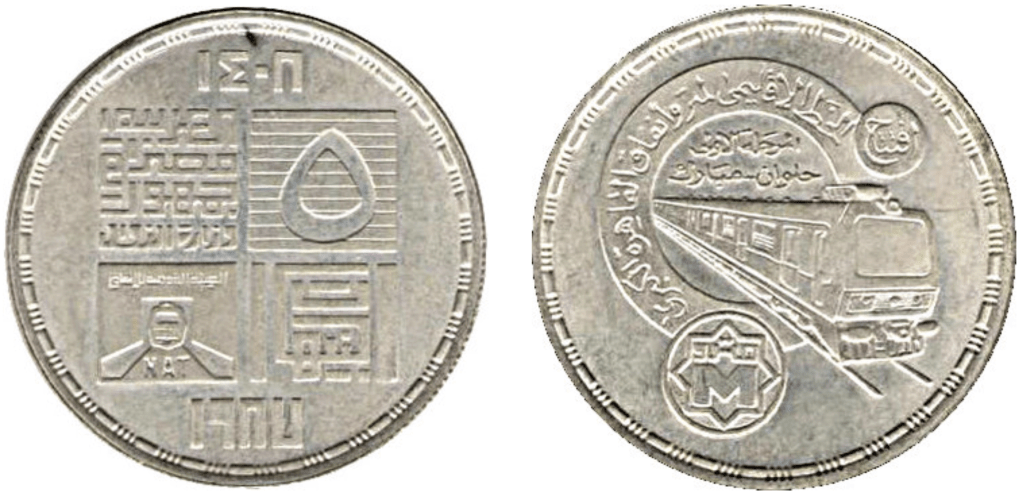
In 1987, Cairo relieved its crowded streets with the opening of the Cairo Metro. The Cairo Metro, which was the first of its kind in the region, only opened with a single line but is now undergoing drastic expansions to serve the ever-growing metropolis.
Naguib Mahfouz Wins 1988 Nobel Prize for Literature: 1988
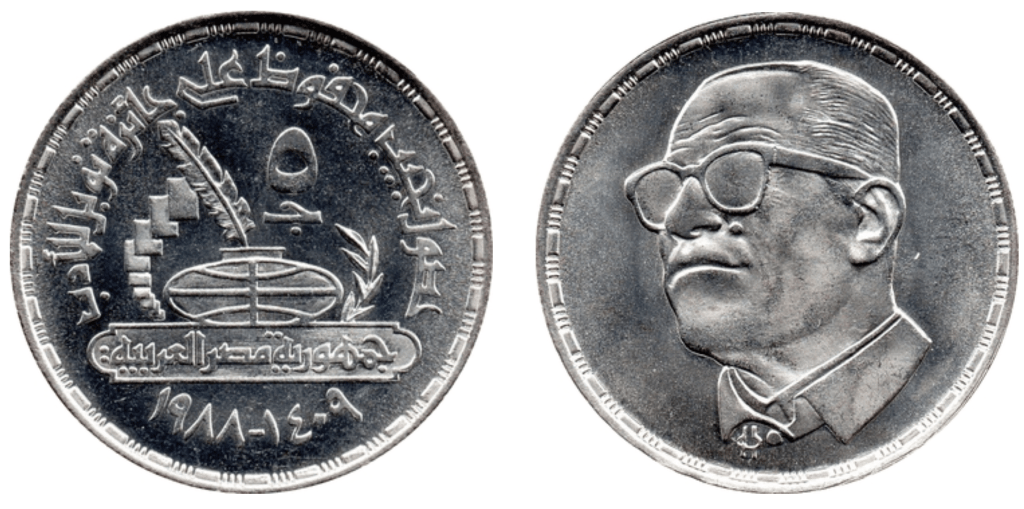
Egypt’s most famous writer, Naguib Mahfouz, won the Nobel Prize for Literature in 1988. As a quintessentially Egyptian writer who wrote about the life of Egyptians, many could relate to his work and felt immense pride in his winning the award.
The Opening of the Bibliotheca Alexandrina: 2022
The opening of the Bibliotheca Alexandrina, or Library of Alexandria, was an important event and promoted as a source of national pride and a symbol of the country’s deep intellectual culture. The building’s distinctive and modern design was also meant to represent a new narrative around Egypt to the rest of the world.
60th Anniversary of the Arab League: 2005
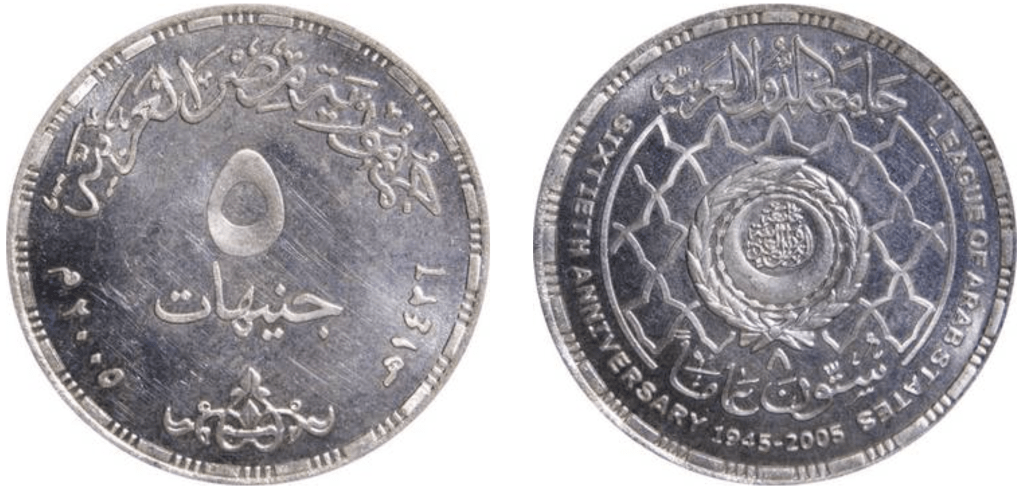
Egypt has historically seen itself as the leader of the Arab region, which started with President Nasser’s charismatic leadership that inspired much of the region but waned considerably after being kicked out of the Arab League in 1979 over its peace treaty with Israel. After being readmitted in 1989 and with the Arab League’s headquarters wedged between Qasr al-Nil Bridge and Tahrir Square in the heart of Cairo, Egypt has been keen to try and reposition itself as the leader of the Arab world.
Books for All, Sponsored by Suzanne Mubarak: 2010
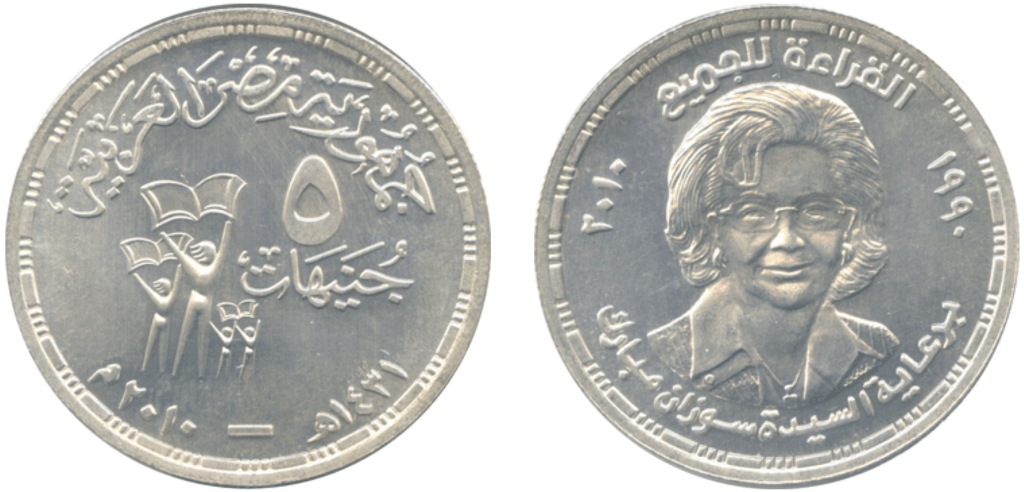
The wife of former Egyptian President Hosni Mubarak, Suzanne Mubarak, was well-known for her work with children and promoting literacy, which this coin commemorates. To my understanding, this was the first time a living political figure or spouse had been featured on an Egyptian coin.
The Egyptian Revolution of 2011: 2011
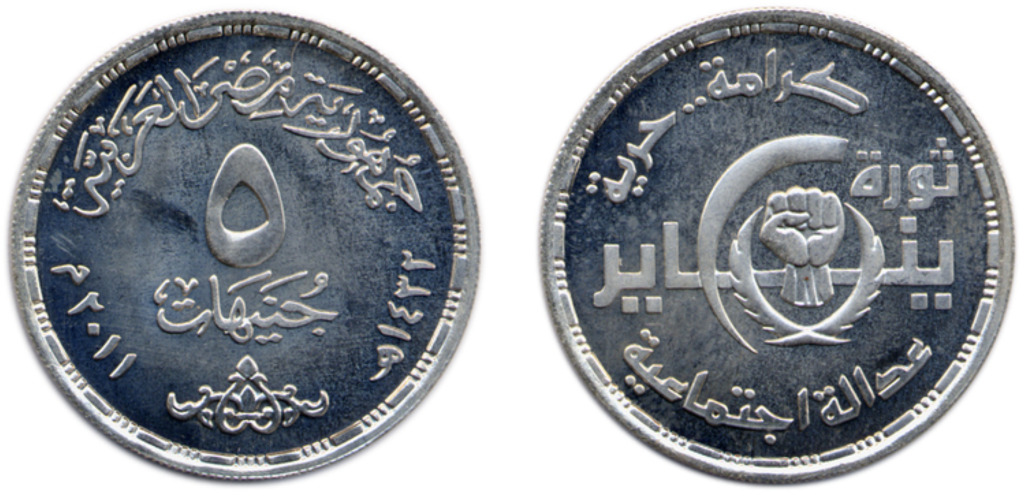
To mark the Egyptian Revolution of 2011 that overthrew President Hosni Mubarak, the Central Bank of Egypt issued a commemorative coin to mark the event. Written on the coin is ‘dignity, freedom, social justice’, three key demands of the revolution.
Opening of the New Branch of the Suez Canal: 2015
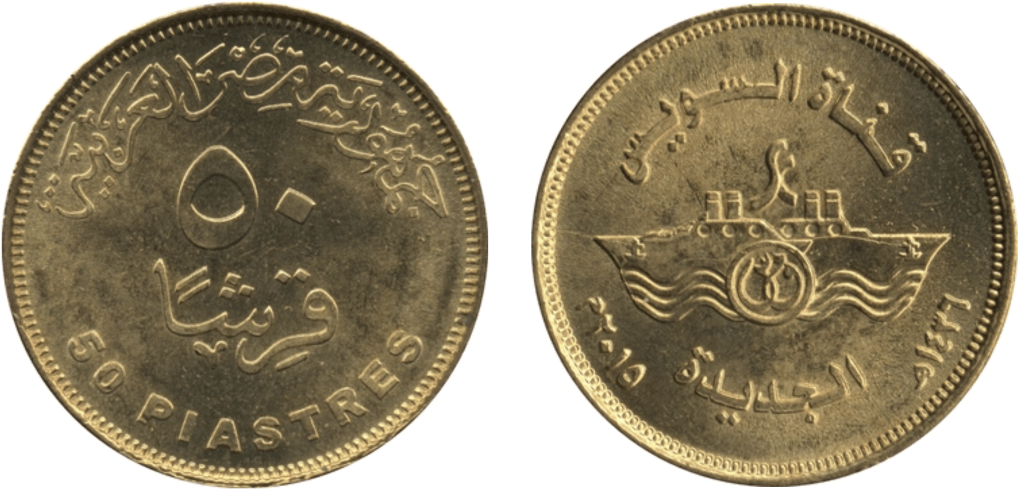
After years of work and enormous amounts of money spent, Egypt opened up a second branch of the Suez Canal to enable more ships to pass. Since 1869, the Suez Canal has been an important part of Egypt’s economy and pursuing impressive infrastructure works like the canal’s second branch has been seen as a way of demonstrating the Egyptian state’s capabilities to attract investment.
New Administrative Capital: 2019
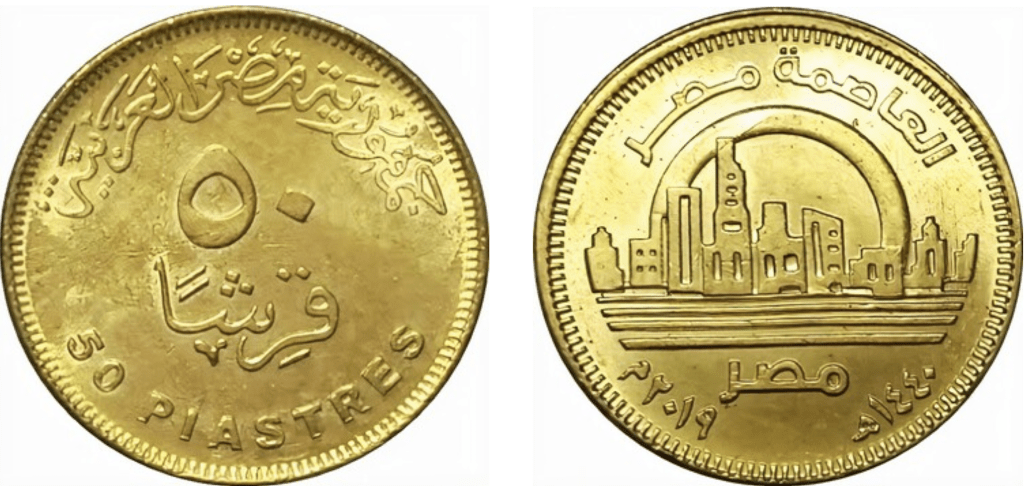
As the embodiment of the state’s modernist aspirations, the New Administrative Capital has become the center point of much of the way the state likes to promote itself. With a skyscraper set to be taller than the world’s current tallest structure and an ambitious city plan, not to mention the amount of money invested, the new capital regardless of its outcome marks an important part of the country’s history.
The Medical Teams Battling the COVID-19 Pandemic: 2020
During the COVID-19 pandemic, medical teams and hospital staff faced gruelingly long shifts and increased danger, which often left them separated from their families for weeks at an end. Many doctors, nurses, and support staff also sadly died of COVID-19, having caught it while trying to help others. In commemoration of their brave and hard work, the Central Bank of Egypt issued this coin to thank them.
The Decent Life Initiative: 2021
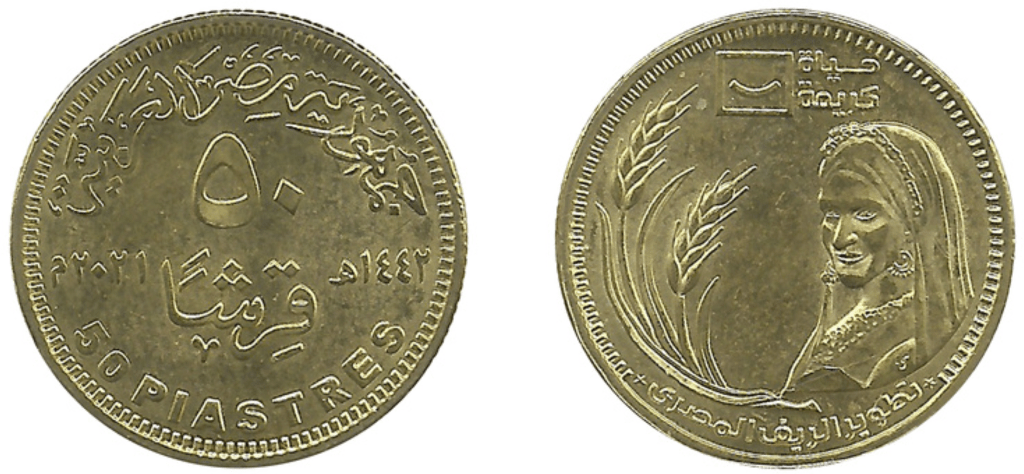
The Decent Life initiative, which was launched in 2019, is a program to channel both government and donated funds to the nation’s most needy. It aims to create real and sustainable development, particularly in rural areas, and give the opportunity to every Egyptian to lead a decent life.
The Pharaohs’ Golden Parade: 2021
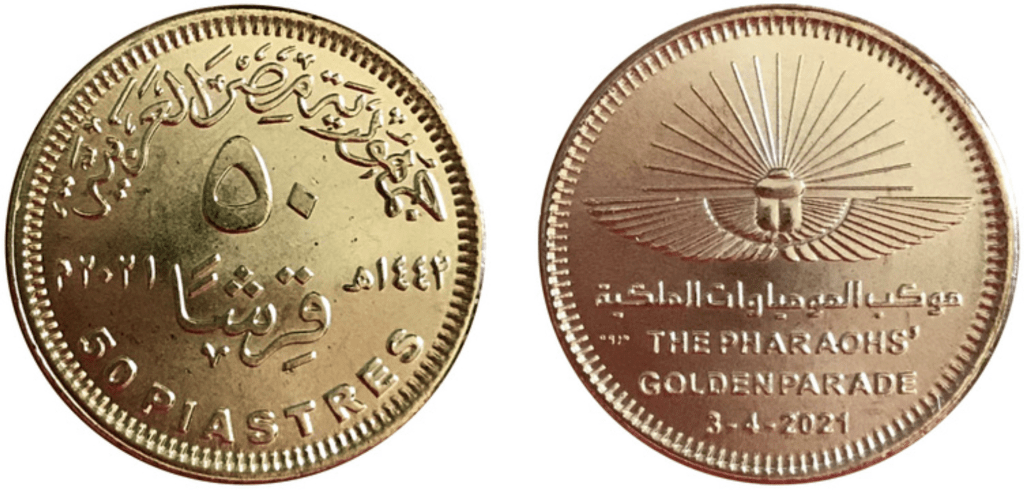
With the opening of the Egyptian Museum of National Civilization and the ever-approaching of the Grand Egyptian Museum at the foot of the Giza plateau, several pharaohs were moved in preparation. Instead of just transporting the mummies, it was thought best to honor the pharaohs of old by holding a grand televised procession.
The Sphinx Avenue – Luxor: 2022

In late 2021, Egypt in a bid to relaunch its tourism industry after that had suffered immensely from the COVID-19 pandemic, reopened the newly restored Sphinx Avenue in Luxor. With a grand procession accompanied by dance, music, and fireworks., the event was meant to be a spectacle and was televised the world over in an effort to signal the country was open again for tourism.
WE SAID THIS: Don’t Miss… Egyptian Coins Throughout The Ages


